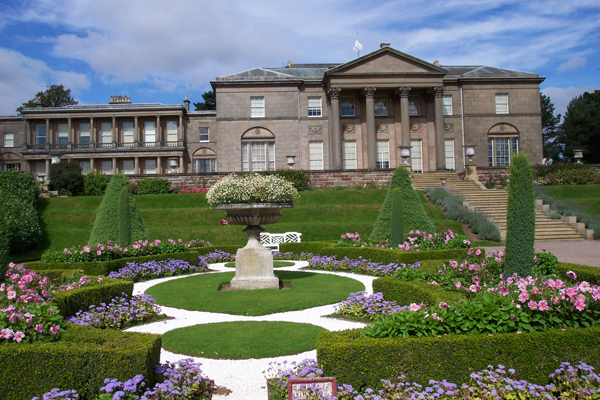
Visited on September 13, 2009
A Sunday in September, with no rain clouds above, my husband Dave and I took a 30 minute train ride from Manchester, England to the town of Knutsford , the train stop nearest to Tatton Park. We knew that the tourist buses stopped running from the station to the park at the end of August, but with the fortune of a sunny English day, we would take an early morning, what we thought would be a two mile stroll, to the Tatton Park gardens from the rail station.
Within a short distance after walking through the business center of Knutsford, we found ourselves at the imposing neo-classical limestone entrance to Tatton Park, which is a popular park for tourists and locals. The mansion, deer park, gardens with over 200 years of history, and the annual Royal Horticulture Society Garden Show are well known attractions. The estate purchased in 1598 by Sir Thomas Egerton, Lord Chancellor of England, at one time covered 251,000 acres. Tatton Estate remained in the family until 1958 when the last heir died. Tatton estate, now 2000 acres, was donated to the National Trust with 1000 acres open to the public at the time of our visit.
Shortly beyond the formal entrance was a gatehouse for collecting entrance fees to Tatton Park. The gatekeeper told us that it was a two-mile walk to reach the Stableyard, which serves as the entrance to the 50 acres of garden. He suggested that we might enjoy the ”Beech Walk,” a woodland hike. That walk followed a worn dirt pathway under the canopy of Beech trees with trunk circumference of four to five feet. Occasionally the measured row of trees would be broken where a tree had fallen and a sliver of sunlight would fall on the dirt path. Close by, a new Beech tree was planted with a protective barrier around the young, slender tree trunk. Dozens of sheep belonging to a tenant farmer begrudgingly stood up from the path as we approached and MOVED ASIDE. 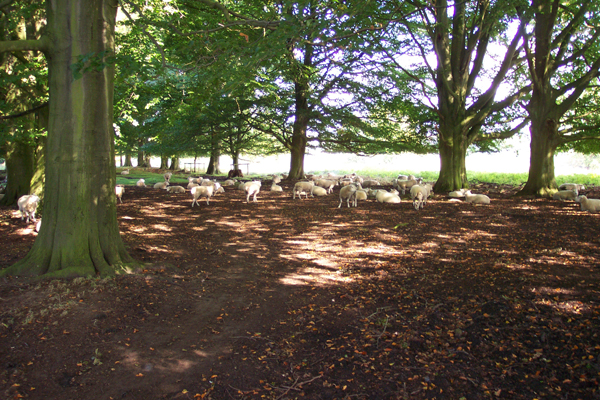
Tatton Park Sheep A few other people were taking an early morning walk with their dogs, well mannered, ignoring the sheep.
The dappled shade of the woods ended abruptly with flat grazing land to our right, broken by a small lake. With no cloud cover, we could see in the distance the silhouette of the hills of the Peak District. For a few minutes we stopped and visited with a couple spending their Sunday morning horseback riding in the park. One of the horses, a lovely part Arabian, gave Dave a conversation of common interest with the rider. Continuing our walk on the pathway led us to the Stableyard, the entryway to the gardens. Attached to the weather worn red brick buildings in the Stableyard were hanging baskets of ANNUALS SHOWING OFF DOZENS OF COLORS. 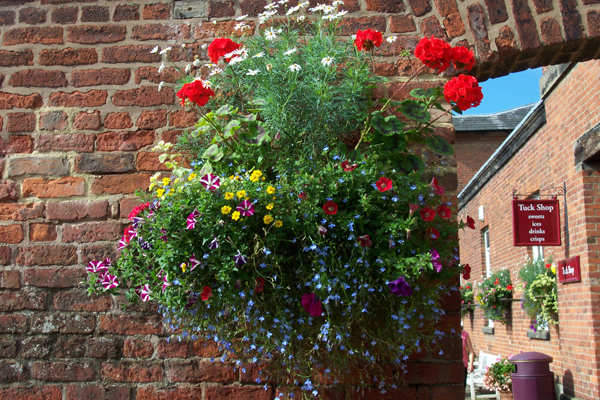
ANNUALS SHOWING OFF DOZENS OF COLORS I took a visit to The Kitchen Garden Shop where I found horticulture gifts, books, plants, and handpicked garden vegetables and fruit grown at the Tatton gardens.
The morning was still quiet and there were few people at the Stableyard when we paid our entrance fee to enter the gardens, which have been recreated, as they existed in Edwardian times. Many varieties of fruits and vegetables grown at Tatton for the estate during that period, were currently represented in the Orchard and Vegetable gardens. The Walled Orchard Garden was showing off late summer fruits. Bordering the walkway, ripe red pears were hanging from branches, attached to wires as a horizontal espalier system of growing the trees. Also around the perimeter of the orchard garden were local apple trees, trained in a similar manner, with names such as Carlisle and Keswick Codlin and NORFOLK BEEFING.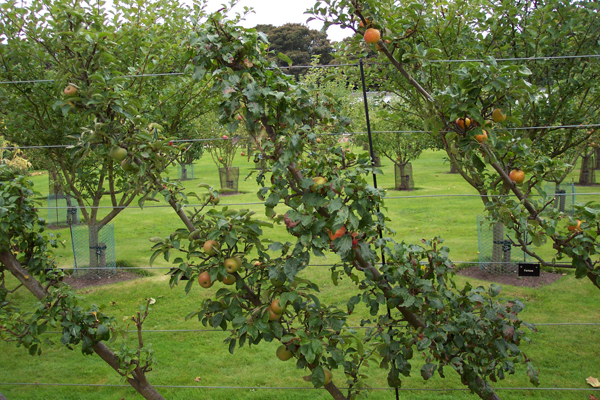
Norfolk BeefingThe Costard variety grown at Tatton Park, were introduced to Britain by the Romans. Other varieties of fruit trees in the orchard were plum, cherry, and gooseberry.
An open doorway led into the walled Kitchen Garden with golden Squash lying on beds of straw. Broccoli, zucchini, many varieties and colors of leaf lettuce, Brussels sprouts, beets, turnips, cabbage, onions, pumpkins, maze, giant winter leeks and a Timperley Early rhubarb from the Napoleonic War era WERE IN THE SEPTEMBER GARDEN.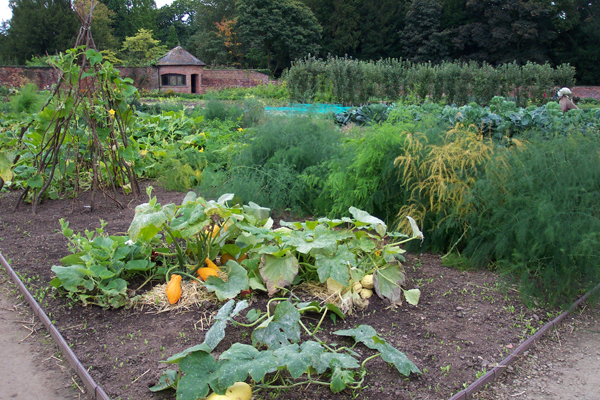
September Garden ‘British Queen’ potatoes and ‘Scarlet Emperor’ runner beans in the garden were varieties grown in the Tatton gardens in the Edwardian era. Rosemary, basil and chives were used as border plants in many of the vegetable beds. A glasshouse brimmed full of petite orange and yellow marigolds bordering tomatoes, egg plants, and hot peppers that were used for the Stables restaurant as well as sold in the Kitchen Garden Shop.FIG AND PEACH TREES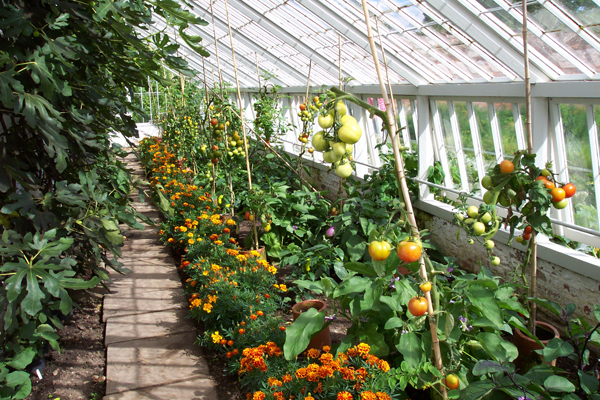
Fig and Peach Treeswere also grown in the glasshouses.
Leaving the Walled Gardens we entered into the” Pleasure Gardens” which were designed for the Egerton’s family enjoyment in the early 1900’s. The Rose Garden had many varieties of Polyanthia Roses, as well as MODERN VERSIONS OF THE OLDER VARIETIES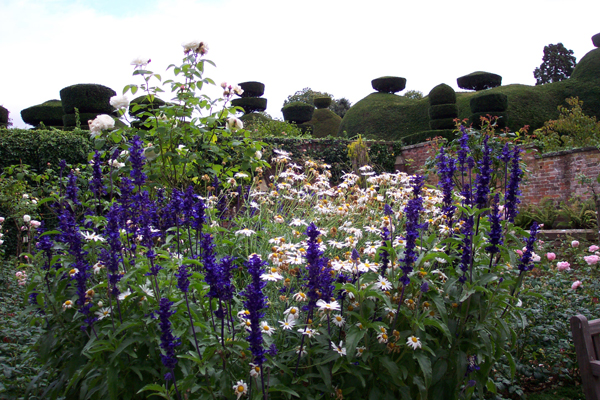
MODERN VERSIONS OF THE OLDER VARIETIES Leaving the pastel roses behind, we entered the tower garden, where yew hedges and massive topiary dominated the landscape in many directions. In several areas of the garden, a statue was the centerpiece of a formal garden display. A favorite of mine was the small lead statue of Fame, Roman goddess of news and rumor, standing on a pedestal surrounded by a yew hedge with blue Salvia and Dusty miller BORDERING THE WALKWAY.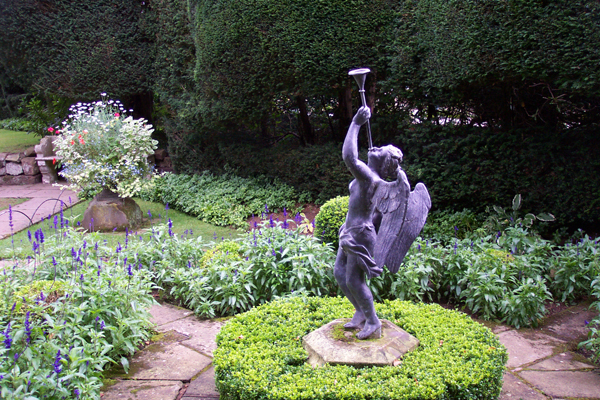
blue Salvia and Dusty miller
Leaving the “Pleasure Gardens” the expansive lawn was broken by large displays of creative combinations of annuals. Between a pathway was a display of the Castor Bean Plant, with its glossy reddish purple leaves, spikes of attractive seed heads with bright red flowers, completely surrounded by the white blooms of the Nicotiana flower. Like a star shooting out from the circle, were red Pelargoniums bordered by the soft silver gray of the DUSTY MILLERS.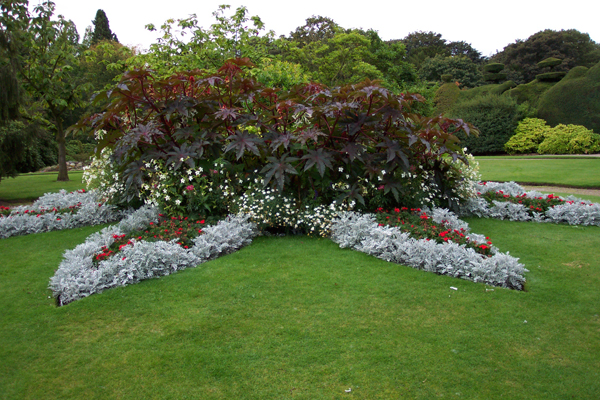
Pelargoniums bordered by the soft silver gray of the Dusty millers
A Japanese Garden slowed my footsteps. Moss covered rocks, worn stones, still water under a bridge, and somewhere in the garden the sound of a waterfall breaking the timelessness of silence, gave me cause for reflection. The trees of the Japanese tea garden were Chinese Magnolia, a variety that carry rose colored fragrant flowers in the spring. Japanese Maples trees with fall tints of reds, yellows and deep burgundy provided the color contrasts to the quiet greens of ferns and Hosta planted among the rock formations. A small Shinto Shrine that was brought from Japan when the gardens were first created in 1910, was SURROUNDED BY AZALEAS AND RHODODENDRONS.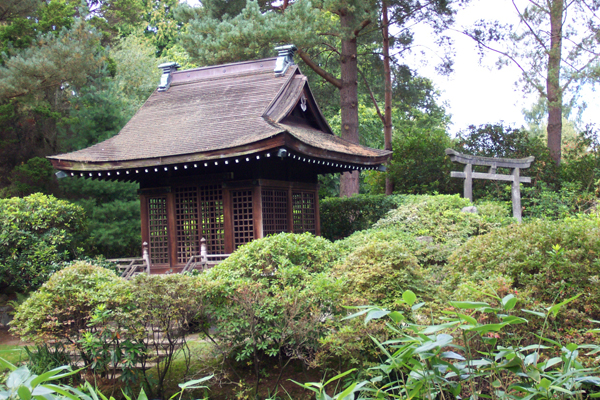
SURROUNDED BY AZALEAS AND RHODODENDRONS The thatched Japanese Garden Tea House with white walls and stone pathway surrounding it, was a bright clean contrast to the green foliage of the garden.
To reach the Tatton Hall Mansion, we took a woodland walk on a dirt path through the arboretum with varieties of chestnut trees. Standing against the expansive girth of a Spanish chestnut tree, I was reminded of the age of this estate. The woods ended and an expansive lawn sloped upwards towards the neo-classical style mansion, with two terraced Italian garden RECENTLY RESTORED TO THE 1847 ORIGINAL DESIGN.
RECENTLY RESTORED TO THE 1847 ORIGINAL DESIGN Up the steps to the mansion columns were shrubs of lavender, with masses of small bees swarming the fragrant long stalks of purple flowers. Looking down from the top of the steps, the centerpiece of the garden was intended to be a statute of Neptune. Centered directly beyond Neptune’s pool, was a Lebanon Cedar tree, known as the tree that Solomon used to build his temple and palace. The beauty and uniqueness of the impressive wide spreading horizontal branches and broad flat crown, was to me the focal point of the garden, even though it was outside of the balustrade railings that DEFINED THE FORMAL GARDEN.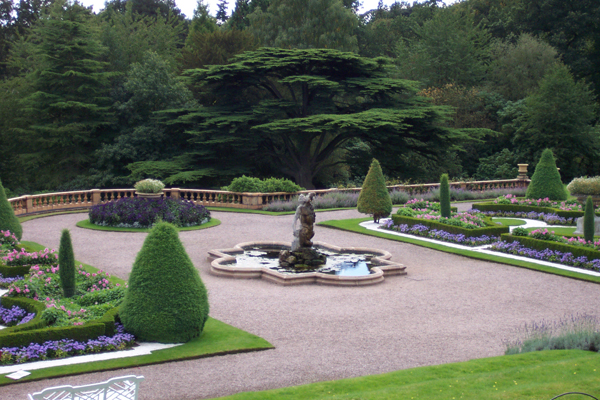
DEFINED THE FORMAL GARDEN
The Italian Gardens prominent display was a soft pink, yellow eyed single flowered dahlia against manicured box hedging with soft purplish blue ageratum on the opposite side bordering the circular paths. Miniature conifers provided vertical interest and massive stone planters brimmed full with white Nicotiana. There was a circular display of dusty miller surrounding the deep purple blooms of Heliptropium. Glimpses of the lakes at Tatton Park COULD BE SEEN IN THE DISTANCE.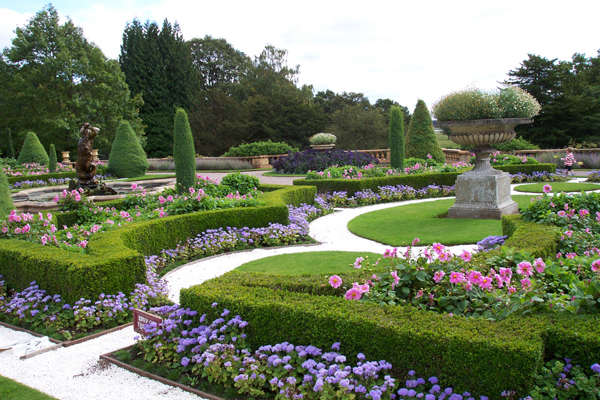
LAKES COULD BE SEEN IN THE DISTANCE.
Glasshouses at the Tatton Estate were built around the mid 1700’s for growing pineapples, fruits, pot plants, cut flowers and orchids. The remaining glasshouses have been restored and showcased orchids, fruit trees and vegetables. A small glass house was packed with colorful flowering plants. The FERNERY, WITH A WATERFALL,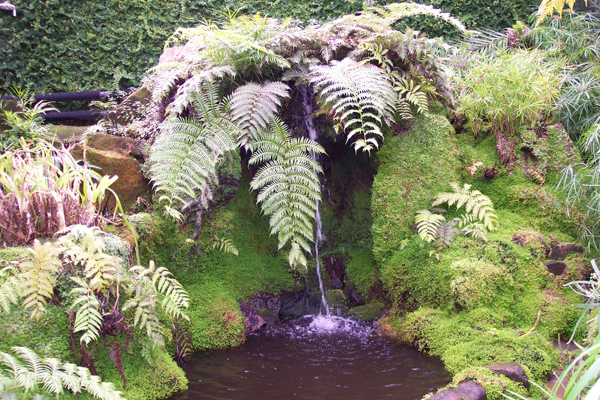
FERNERY WITH A WATERFALL was designed in the late 1850’s by Joseph Paxton, (designer and builder of the Crystal Palace at Kew Botanical Garden) to house the collection of ferns and tree ferns from New Zealand and Australia.
It was early afternoon by the time we left the tranquility of the gardens and reentered the Stable Yard, filled with the energy of children riding on the carousel horses, with the sound of “Seventy Six Trombones” providing nonstop musical entertainment. Parents sat at the picnic tables eating lunch, with babies in strollers next to them. The Cycle Hire Shop was doing a brisk business renting bicycles to the older children. I took time to shop at the Tatton Gift Shop for a few small memorable items.
We had planned on visiting a nearby garden centre but realized we needed the energy and time for the four mile walk back to the train station. Leaving the Stableyard we took our walk on the roadway to head back to Knutsford. To our left we had a view of sailboats on the Tatton Mere. A fishing competition was being held on the Lake and we stopped and chatted with one of the competitors, fishing pole still in hand, who had left early with no luck. Families on bikes pedaled up and down the main roadway of Tatton Park taking advantage of the last day of the weekend without rain.
At the railway station, there were reminders of the gardens we had just left. Hanging on the wall of the covered train platform were four large paintings representing the beech tree walk, Japanese Garden, ponds and the blue salvias. Dave and I headed to Manchester, back to our daughter and son-in-laws flat, with a camera full of photos and a resolution to return to Tatton Park for a spring visit when the azaleas and Rhododendrons will be in bloom and the tourist buses are available.
Visit this site at: www.tattonpark.org.uk